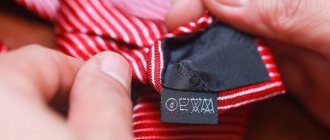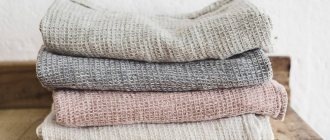A convenient and comfortable wool sweater is definitely in every person’s wardrobe. Warm wool is the best protection against the cold, but improper washing can bring an unpleasant surprise. Having taken the item out of the machine, you may be surprised to notice that now this item of clothing will only fit on a cat, and that is not a fact, or, on the contrary, it is becoming too big. To avoid finding yourself in this situation, you need to know in advance what the rules are for washing and drying a sweater.
Wool clothing requires more attention than synthetic clothing. Clothing labels include tips for washing, ironing and drying.
General rules for washing woolen clothes
To prevent your favorite item from increasing in size or shrinking, you should follow simple rules for washing clothes:
Wool is washed as rarely as possible. These things are not fans of water, so avoid it if possible. If the sweater has absorbed an unpleasant odor, refresh it by hanging it in the air; Do not leave wool in water for a long time before washing. If you do not want to deform or reduce the size of the item, then do not keep it in water for a long time; Maintain temperature stability. If woolen clothes are washed in water at one temperature, and then rinsed in too hot or cold water, then after that they will certainly change size.
Follow the basic washing rules, then your favorite sweater will delight you for a long time.
To prevent the sweater from shrinking and stretching, you should not use extreme water temperatures. The best option would be 30 degrees.
How to iron a sheepskin coat safely - learning ways
There are many ways to iron a sheepskin coat without resorting to the services of professionals.
- Method one: let the product hang on hangers for one to two weeks. Yes, it takes a long time, but it is completely safe.
- Method two: steam the sheepskin coat over a bath of hot water. The bathroom should be tightly closed to keep the hot steam as long as possible. The “bath” time is about half an hour.
- Method three: treat the jammed areas with a steamer on an iron or a special steam generator. Processing each fold should last approximately twenty minutes. The permissible distance to the surface of the product is ten centimeters.
- Method four: ironing. You can iron the folds on a sheepskin coat with a regular iron. The temperature should be minimal, without steaming. Ironing must be done through thin wrapping paper.
Important! When steaming a sheepskin coat, you need to ensure that moisture does not get (or form) on the surface. This can ruin your skin.
Conclusion
We hope our article will help you quickly put in order such outerwear as a raincoat, sheepskin coat, or faux fur coat. We will be glad to see your comments on the article!
Hand washing a wool sweater
It is better to wash a wool sweater by hand. This way you definitely won't harm him. Start by turning the garment over to the wrong side. Take a container and fill it with water no more than 35 degrees. If the item is made of delicate wool, then it is more advisable to use liquid wool powder. But if this is not the case, then use simple shampoo.
Do not place the item in clean water. To begin, pour the product or pour the powder and dissolve thoroughly, whipping into foam. Only then place clothes in the container.
You cannot wash or rub such things too much, otherwise the wool will mat and lose its beauty. It is enough to wrinkle the sweater a little in the foam. Then rinse it in water with a suitable wool product added. Remember that you cannot use too cold water for rinsing; use the same temperature as for washing.
Washing a wool sweater in a machine
If you are unable to clean a wool sweater with your hands, you can use an automatic washing machine. In addition to the powder, it is important to add rinse aid. Remember that you should not put other things in the drum, and it is also important to choose the right mode:
washing such items in a machine is risky, since you may end up with a very shrunken item of clothing; be sure to purchase a suitable powder and rinse for wool; place the sweater in the laundry bag; pour detergents into the compartments and add conditioner; set the appropriate mode. Machines often have a special function for woolen clothes. If this is not the case, then choose hand wash or delicate wash. This is the only way to ensure the safety of the product;
For wool clothing, hand washing is preferable. Machine assistance is rarely used and only when absolutely necessary.
To avoid damage, it is important to carefully select the water temperature. Too hot causes shrinkage, so check the temperature when setting the mode. Suitable 30 degrees; sometimes the mode setting has to be done manually; turn off spin. Even if you use a gentle setting, the item is damaged, since the drum speed reaches at least 500 revolutions. And you shouldn’t wring out a wool item even when washing it by hand. Wait a little after the end of the program until the water drains on its own.
In order not to increase the size of the sweater, it is also important to set a regime that is not too long - no more than 40 minutes. Remember that frequent use of machine washing degrades the quality of wool sweaters.
What things should not be ironed?
But not all things can be ironed. Some products and fabrics cannot be ironed or steamed:
- polyester - manufacturers often prohibit ironing it, but if necessary, you can iron the fabric through the fabric at a minimum temperature (not higher than 110 degrees);
- polyamide is a type of polyester, the hot processing method is the same, but the iron temperature should not exceed 110 degrees;
- nylon is dried on special forms or hangers;
- terry sheets, towels, and bathrobes lose their softness when ironed;
- products that have grease, coffee and other stains.
What to do with an item that needs ironing if there is a “Do not iron” icon on the label, indicating that ironing is contraindicated for the fabric? Products made from delicate materials are indeed very capricious, and contact with the hot iron platform almost always leads to scorching and deformation. Therefore, it is better to wash such products by turning on the mode for delicate fabrics, and dry them on special forms or hangers.
If the material still needs to be ironed, then the item, previously turned inside out, is placed on the pillow. Then place slightly moistened gauze or other thin fabric on top, and barely touch the iron, set to the lowest possible temperature, smooth the product.
Important nuances
If you like your sweater and don’t want it to soon become unwearable, then be sure to remember the important nuances of caring for wool products:
If stains form on woolen clothes, do not rush to wash them. Dry the area with the stain, and then remove it with a brush; other types of stains are removed by using a solution of ammonia and vinegar, salt and water. Mix these components in equal parts and soak natural fabric in the solution. Then tap it on the dirt. Now you can’t stain, it will stretch the tissue and small pellets will appear;
It is better to clean an Angora wool sweater using shampoo. This will keep the fur fluffy longer; You can get rid of yellowness by using water and lemon juice; You can wash woolen clothes like this: pour a handful of mustard powder into 3 liters of boiling water and cool to 30 degrees. The solution is foamed. This will help you wash your sweater easily; To prevent the button loops from stretching, they need to be basted a little before washing.
other methods
If for some reason the standard method is not suitable, there are other ironing options.
Aweigh
You can iron the material in another way. To do this, there is no need to remove the fabric, since the ironing process takes place on weight. For this purpose, a small attachment from an ironing board is used to iron sleeves. It is pressed on one side of the fabric, and the iron is moved along the opposite side.
There is another option to get even material by weight. The ironing board is placed right next to the window. The product begins to be processed on one side. When part of the canvas is flat, the curtains are hung on the cornice. Afterwards, the remaining area is placed on the ironing board and ironed further. There is no fear that new creases will appear on the ironed side.
Without iron
If the canvas is small, it can be smoothed without the use of special tools. Something heavy is placed on top of a flat section. Under pressure, the fabric becomes smooth. You can also spray it with water and dry it with a hairdryer.
To remove creases, prepare a solution based on vinegar, water and fabric softener. The components are mixed and the spray bottle is filled with liquid. The components are taken in equal parts. The fabric is sprayed and then allowed to dry completely.
Own weight
One of the easiest ways to straighten curtains and curtains. After washing, they are hung on the ledge. The fabric should be wrung out, but still remain damp. Water should not flow onto the floor. As the fabric dries, it becomes even. The result is ensured due to the material’s own weight.
How to dry a wool sweater
Even if there is no surprise after washing, the item is easily damaged if it is not dried properly. To prevent this from affecting you, you should not twist the sweater after washing, just wrinkle it a little. This is done carefully, without effort. It is enough to leave the sweater on a stand or in a basin to allow the water to drain.
After a couple of hours, the sweater begins to dry. For this purpose, carefully spread it on a towel, trying not to stretch it, and then roll it into a sausage. Give the fabric time to absorb the water from the item. Then unwind the “sausage” and repeat the manipulations again, but with a dry towel.
Next step: lay out the sweater on a flat surface, first laying down a sheet. Dry your clothes in this position for several hours. Remember, to prevent the sweater from shrinking in size, do not leave it in the sun or on a heater.
Drying and ironing are no less important nuances. There are also certain rules for wool sweaters.
There is a certain trick: if you pull a wet sweater to the sides when drying, you can stretch it a little if it has shrunk a little. Along with this, the product is reduced by folding and then laid out near a heat source.
Basic ironing modes
Even novice housewives know that the iron can be used in several modes. But not everyone understands the intricacies of the differences between different ironing methods. But the result largely depends on the right choice!
There are three main modes of using the iron:
- The dry regime is the most ancient. It was used in the very first irons, in which heating was carried out by the heat of coals embedded in the body. The smoothing effect in this mode is provided by the weight of the iron, the sliding of its sole and the surface temperature. The main disadvantage of the regime is the high risk of damage to things. If you hold the iron in one place, a charred spot will appear.
- Ironing dampened fabric. In this case, the product to be smoothed is wetted using a spray bottle or wet gauze. Moisture makes fabric fibers softer, reduces friction and makes ironing easier. The disadvantage of this method is the need to manipulate additional devices. It takes experience to learn how to properly moisturize your clothes.
- Steaming mode. In it, the iron creates a stream of steam, which is directed through special holes on the sole onto the item. Steam allows you to effectively and quickly deal with wrinkles on fabric. However, the built-in steamer complicated the design of the iron, which means it increased the price of the device and made it more difficult to operate and care for.
The preference for one mode or another should not negatively affect the service life of the iron
But it is important to understand in what cases each ironing method is used, otherwise more labor will be required. The risk of clothing damage if ironing is done incorrectly also increases.
How to iron a wool sweater
After drying, ironing is often not necessary. But if the folds remain, you can iron the sweater. All products have a label indicating care instructions. If it is missing or worn out, then follow the general rules for ironing wool products:
iron the wool only after it is completely dry; before manipulation, turn it inside out; to avoid the appearance of shiny stripes, pass the iron through gauze or cotton fabric; The iron cannot be “pulled” over the sweater; it must be “lowered” onto it. This will preserve the shape of the product; The appropriate temperature for wool is often written on the iron. Usually this is the 2nd division.
We hope that such information will help you in caring for your favorite sweaters, which will delight the eye with pleasant cleanliness and impeccable quality. But it’s also worth considering the nuances of correcting errors if they have already happened.
How to tidy up cotton and linen items
Almost no one has a question at what temperature to iron cotton or linen: you need to set the maximum value on the relay and you can start working. But the fabric, unassuming at first glance, is quite difficult to smooth out, always remaining slightly wrinkled. How to avoid this effect?
It is important to know: steaming is the only way to properly iron a cotton or linen product.
It is equally important to set the temperature correctly:
- 100% cotton should be ironed at a temperature of 150 to 200 degrees, with powerful steaming or spraying water with a spray bottle;
- cotton is diluted with polyester - in this case, the ironing temperature is no more than 110 degrees, the amount of steam and water is limited to a minimum;
- The material contains cotton and linen threads - the relay is set to 180-200 degrees, and the item is generously moistened with water.
Linen can only be exposed to very high temperatures - up to 230 degrees. The product is ironed from the front side, so you must be careful not to burn the item.
Restoring a sweater after deformation
What to do if an unpleasant situation has already occurred after washing a sweater? How is a sweater restored when it shrinks or stretches?
In order to increase the size of shrunken clothes, you need to wet them again, in addition to the neck and shoulders. Do not twist it, but wrap it in a towel. When the excess liquid is absorbed, stretch the sweater in different directions and hang it on a trempel, wrapping it with fabric. Another option for increasing the size: wet the item and lay it out to dry. From time to time you need to stretch it with your hands, remembering the sleeves. After almost complete drying, the sweater is hung on the trempel.
If trouble has already happened, then you can try to fix it. But all methods help only with minor changes.
Treat the item with a vinegar solution for steaming. Pour more vinegar into the water into the container and, without touching the product with the iron, steam it. While the wool is heated, stretch it with your hands, not letting go until it cools. You can also steam a piece of clothing through gauze. But they do this at low temperatures so as not to experience large shrinkage in size. There is another, unpleasant, but effective method - put the wet thing on yourself and wait for it to dry.
It happens that the sweater increases in size, then you need to tighten it. Soak the item for 15 minutes in hot water and wash by hand. But remember that trying to shrink a sweater by using a machine wash will result in complete destruction of the garment, because it will not be possible to achieve an even reduction.
Temperature conditions for ironing main types of fabrics
Linen
Linen clothing has excellent breathable and thermal conductivity properties. With proper care, it retains its qualities for a long time. To ensure that linen items do not lose their original appearance, they require special care.
How to iron linen correctly:
- The iron temperature when ironing should be 180–200 °C (3 points).
- Turn inside out.
- Provide moisture to clothing. It is better to treat almost immediately after washing or use a spray bottle.
- Intense pressure on the iron.
- Allows you to turn on the steam function.
High-quality ironing of natural linen requires high temperature and humidity. We must not forget that this fabric wrinkles easily, so achieving an ideal result will be quite difficult.
If the material contains additions of other fibers, for example, cotton, then the temperature should not be set above 180 °C.
Particular attention should be paid to the presence of decorative elements. Embroideries and patterns are ironed exclusively from the inside and only through gauze
Direct contact with the base of the device is not allowed.
Very thick clothes are ironed on both sides, but using gauze. For starched items, the temperature should be reduced by about 10–20 °C from the maximum.
Cotton
Clothing made from this material is the most popular. Cotton is a fairly dense fabric that perfectly absorbs moisture and allows air to pass through well. It is used to make bed linen, dresses, shirts and many other things. To properly iron your products, you should follow these recommendations:
- Ironing temperature for cotton is 170–180°C.
- Do not dry completely. Treat wet or using a spray bottle.
- Press firmly on the iron.
- Using wet steam.
In its pure form, cotton is quite difficult to iron. The process requires high temperature and strong pressure. If the item contains the addition of polyester, the heating of the sole must be reduced to 110 °C.
Products without patterns or embroidery are processed from the outside; if there are decorative elements or paints, the clothes must be turned inside out. To obtain maximum effect, you must follow the recommendations indicated on the clothing label.
Silk
Silk is a delicate material that requires careful handling. It dries quickly and has a delicate texture. The fabric is very sensitive to external influences, so you need to know the main rules on how to iron silk.
Rules:
- Silk ironing temperature 60–80 °C (one dot or corresponding inscription on the device panel).
- The use of steam is prohibited. Difficult to remove stains may remain.
- Use a thin cloth, but not gauze. She also leaves streaks on the silk. In this case, a temperature increase of 10–20 is permissible.
- The direction of movement is vertical. Otherwise, the fabric may stretch.
How to iron a silk dress or shirt with a complex cut:
- Hang the product on hangers.
- Cover the top with a thin, slightly damp cloth.
- Heat the device to the temperature indicated on the label. If it is not possible to view the information, then set the mode to 1 point or 1 point on the iron.
- Slowly move the steam at a distance of 4–7 cm from the dress using vertical movements.
The same rules should be followed when working with chiffon and polyester.
Wool
Soft, natural material that is resistant to high temperatures. For safe ironing, you should adhere to the following rules:
- Temperature for ironing wool is 100–120 °C.
- Turn inside out.
- It is better to replace continuous moving of the iron by moving it from place to place. This method will avoid deformation of the fabric.
- Use additional moisture in the form of cotton fabric.
Woolen items are very finicky and do not always tolerate ironing. Read label recommendations carefully. It is better to give preference to vertical steaming for the ironing process.
Viscose
To avoid damage to clothes made from this material, use the following tips:
- Temperature maximum 120 °C.
- It is forbidden to get it wet, otherwise there will be streaks.
- Process only from the inside out.
- Use damp gauze or cotton cloth.
Chintz
Lightweight, thin, highly breathable material. For effective ironing you need:
- Do not increase the temperature above 170 °C.
- Iron from the front side of the product.
- Press firmly on the iron.
- Additional hydration.
Correctly selected ironing temperature is the key to obtaining excellent results.
How to return a sweater to white
It happens that over time, things made of wool lose their whiteness and a yellow tint appears. How to return the white color to a product? Is there a way to get rid of yellowness?
Due to exposure to the sun and hard water, a white sweater can easily change color to yellowish. The situation can be corrected without dry cleaning. For this, there are special stain removers that are designed for natural materials, including wool.
But before using them, use gentle methods. As an example, soaking in powder with bleach. In this situation, the sweater should be allowed to rest in the middle of the process. And after a couple of washes it will almost restore the color.
If whitening powder does not help, then use peroxide. It should be added to the water during the washing process, in the amount of 3 spoons per 1 liter of water. In such a situation, the item should be left in water overnight. Often, only 2-3 similar manipulations are needed to refresh the color.
Bleaching often fails due to contamination not of the threads, but of the spools. In such a situation, use emollients with bleach. They will help untangle threads and remove dirt.
If all efforts do not produce results, then you should turn to professionals for help, that is, dry cleaning. If nothing helps here, then it’s time to say goodbye to the thing and look for a replacement.
Steaming woolen items
To avoid loss of shape, woolen blouses are steamed using a steam generator. This function is also available on modern irons.
Steaming rules:
- Iron the pullover horizontally.
- Lay out the jumper evenly, securing the ends with needles.
- After steaming, do not touch the item and leave it in this position.
Steaming with a steam generator:
- Lay out the pullover according to the instructions, pin the elements with pins.
- Pour water into the steam generator tank and heat it to the desired temperature.
- Walk over the surface of the clothing at a distance of 5-6 cm.
It is prohibited to steam sweaters made of coarse threads, mohair and openwork knitting with an iron. The principle of steaming is the same as with a steam generator.
Other steaming methods:
- Hairdryer. Cover the pullover with damp gauze. Use a hairdryer over the product at maximum temperature and speed.
- Fill the bathtub with boiling water, install a large wire rack on which to place a woolen turtleneck.
- Hang the clothes on a hanger and hang them over a bowl of boiling water until the item dries.
Sweaters are brought into shape using another method: they are wrapped in a terry towel, removing excess moisture. The wet jumper is straightened and left to dry completely.











